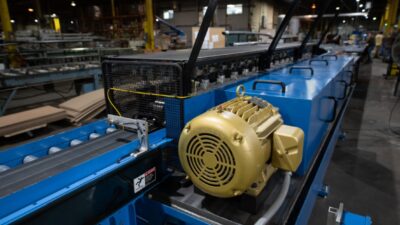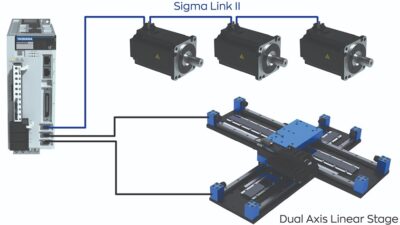They come in many shapes, sizes, and configurations—from large slow-speed, direct-drive rotary torque motors to sleek, compact units with low rotor-inertia for optimum acceleration and deceleration of loads, to frameless motors, to linear motors providing high thrust force under extreme acceleration and speed.
| Ranking of performance features users consider “very important” has remained relatively unchanged over several surveys. Pricing of servo motors was most important in a separate set of functional features.. |
They come in many shapes, sizes, and configurations—from large slow-speed, direct-drive rotary torque motors to sleek, compact units with low rotor-inertia for optimum acceleration and deceleration of loads, to frameless motors, to linear motors providing high thrust force under extreme acceleration and speed. Combined with modern servo drives that incorporate advanced control algorithms, today’s servo motors offer users the highest level of motion control for myriad applications.
To survey trends in this product sector, Control Engineering and Reed Corporate Research—both part of Reed Business Information ( www.reedbusiness.com )—asked subscribers about their views and preferences on electric servo motors via an e-mail survey. Selected results discussed here are based on 134 responses received in December 2005 from subscribers who evaluate, specify, recommend, install, and/or purchase servo motors. Among these, 51% do so for in-plant requirements, 23% for OEM (resale), and 25% for both functions.
Drilling down on how servo motors are being implemented in projects, the latest survey finds new applications account for 52% of units purchased, while retrofits and replacements comprise 22% and 26% of motors, respectively. These results are very similar to surveys in 2004 and 2003. Brushless type servos dominate the market, with 90% of respondents indicating this preference versus 10% for brush dc.
Desired features
Pricing was by far the most important functional feature of servo motors according to 58% of respondents—followed by standard NEMA sizes (43%), type of motor mounting (38%), and EMI/RFI protection (38%). Order of these “very important” selection features ran 1st, 2nd, 6th, and 3rdin the last survey (2004). As for performance features rated “very important,” the top choices were software for setup/tuning, high output torque (continuous), and high torque at low speed (see details in “Desired features” graphic).
Rockwell Automation agrees about the importance of high motor torque output for many applications, including material handling and packaging. Today, this capability is delivered by more compact, power-dense technology—such as Allen-Bradley MP-Series—than traditional servo motors offered, explains Tom Strigel, product marketing manager, Kinetix Motion Control at Rockwell. “Ability to use powerful motors in small spaces enables building machines that are compact, lighter, and more dynamic for greater productivity in a smaller footprint,” he says.
A significant industry trend cited by Strigel is extending servo motion systems’ productivity enhancements into hostile environments with stringent cleanliness requirements, such as in food/beverage, brewing, and life sciences industries. Anticipating this demand, Rockwell Automation has developed two suitable product families: MP-Series Food Grade Motor and MP-Series Stainless Steel Motor.
Software is key
Beyond external environmental needs, servo-related software has been translating into easier motor setup and tuning at Baldor Electric, with autotuning, in particular, playing a big role. John Mazurkiewicz, servo product manager, claims that Baldor’s autotuning program has the unique advantage to setup loops for current, velocity, and also position. “These Microsoft Windows-based graphical tools enable viewing of many different parameters on a ‘software oscilloscope’ to allow engineers to fine-tune response—as well as monitor machine I/O points and other key machine parameters,” he says. Low-pass and notch filters that allow filtering of machine resonances also are available in the setup software.
Moreover, software-based control permits variable-gain settings, that is, a number of parameters can be stored and switched easily. “This may be used in applications where the load is known to change; for example, in a machine tool with different [cutting] tools, or a robot arm carrying different loads. Adaptive control will become popular, with the ability to adapt itself to changing loads,” adds Mazurkiewicz.
Trends noted at Baldor include higher line-count encoder feedback—such as SSI (Serial Synchronous Interface)—and movement toward absolute encoders. Encoders with higher resolution offer better velocity control of servo motors and greater positional accuracy. However, for absolute encoders to catch on widely in North America, Mazurkiewicz sees the need for significant price reduction.
Baldor likewise mentions servo motors’ ability to handle rigors of food processing and packaging applications, typically high-pressure washdowns. The company’s stainless-steel brushless motors meet or exceed baking industry sanitation requirements (see Products Section of this article).
Flexibility offered by setup/tuning software also is highly valued. Emerson Control Techniques touts the ability of its servo drives to work with a wide range of servo motors. Its software lets users select a motor from a drop-down list or, in case of a custom motor, they can use a simple built-in autotuning procedure to determine the motor’s characteristics, explains Shane A. Beilke, strategic planning manager. “Our State-Space control algorithm allows our drives to operate with a wide range of inertia mismatches, greatly reducing time spent tuning.”
Among trend in servo motors noted by Control Techniques are:
-
Continuation of more compact designs with higher torque densities;
-
Higher speeds and multiple speed ratings in a given frame and stack length;
-
Continued replacement of stepper systems as price continues to be more competitive (servo performance/quality and near-stepper prices); and
-
Higher performance feedback devices; increased line densities and absolute encoders.
Smaller, more powerful units
The need for better servo tuning is increasing, as performance demands on smaller motors push their speed and acceleration ratings upward. “Proper servo system tuning sets the foundation for the machine’s potential performance,” says Paul Webster, product manager in GE Fanuc’s CNC Division. “Specific tuning software ensures a solid foundation before adding controller features.”
The company uses software called Fanuc Servo Guide, which combines intuitive parameter setup, test program generation, graphing functions, and servo tuning wizards into one PC-based package. This type of program, notes Webster, appeals to new and experienced users. Newcomers benefit from ability to step through initial servo tuning without the need for lots of system knowledge, while veteran users have access to every system feature.
“Synchronous servo motors have the ability to produce high power output at any point in the speed range while maintaining a very small footprint,” states Webster. However, designing high power motors typically requires a trade-off between high torque and feed smoothness (for CNC applications), he explains. Fine balance is required to set magnetic field strength to gain torque output yet limit cogging. “Use of finite-element-method analysis to design internal permanent magnet (IPM) motors that employ high-density, rare-earth magnets strikes an excellent balance between power and precision,” he adds. (See Oct. 2005 CE , for an article on IPM servo motors at www.controleng.com/archives .)
More networking
This latest survey shows 51% of respondents networking their servo motors, compared to 29% and 36% in the 2004 and 2003 surveys. DeviceNet and Ethernet are running neck and neck as the preferred network, with 57% and 55%, respectively in 2006—among those indicating networked motors. Figures for ’04 and ’03 were: DeviceNet (51%, 71%); Ethernet (56%, 59%). However, the future bodes well for Ethernet as “plan to use” figures have consistently outpaced “current use” figures over several surveys. In the latest results, Ethernet leads with 73% of respondents indicating plan to use in the next 12 months.
Other current networking choices include SERCOS 55% (39.9% in ’04), Profibus 38% (36%), Modbus 35% (32%), Ethernet Powerlink 18% (and 34% plan to use)—a new entrant since the 2004 survey—and Firewire 15% (6%).
Rounding out survey findings are:
-
Users prefer to buy matched motors and controllers (71% of respondents);
-
Motor speed capability of 3,000 rpm or less satisfies 71% of users—only 8% require 6-10 krpm and 6% over 10,000 rpm;
-
Thirty percent currently use linear servo motors, while another 27% plan to use them in the next year; and
-
On average, each respondent spent $140,600 on servo motors in the past year.
Servo motor products
For more manufacturers, visit www.cesuppliersearch.com . For more information on products described here, visit the Web sites listed.
Low-inertia, small-frame servo
Addition of two new frame sizes (63 and 75 mm) to Rockwell Automation’s Allen-Bradley MP-Series low inertia (MPL) servo motor family offers users a compact, modular design suited for applications needing less torque and weight. Motors work from supply voltage up to 460 V, producing continuous torque in the range of 0.25-2 Nm (2.2-17.7 lb-in.) for use in a wide range of motion-control applications. This addition to the MPL family gives OEMs flexibility to design machines that are precisely the right fit for their customers, explains Adam Shively, product manager at Rockwell Automation. www.rockwell.com Rockwell Automation
All stainless-steel brushless servos
SSBSM-Series (stainless-steel brushless servo motors) from Baldor Electric are designed for food/liquid and high-hygiene applications. Totally stainless-steel design—shaft, housing, and connectors—make the motors suitable for pharmaceutical and food processing. SSBSM-Series includes FDA shaft seal and bearing grease that complies with food-industry standards. Motors also can be applied in harsh, corrosive environments. They’re designed to withstand high-pressure washdown, capable of handling 1,500 psi, and rated for IP67. Design detail includes laser-etched nameplate information on the motor case to eliminate surfaces where bacteria could cling. These servo motors have UL/CE/CSA and BISSC (Baking Industry Sanitation Standard Committee) approvals. www.baldor.com Baldor Electric
450 kW max servo motor
GE Fanuc’s iS 3000/2000HV produces 3,000 Nm (2,210 lb-ft) of torque at stall and intermittent power of 450 kW. Output is achieved by using an internal permanent magnet (IPM) design and rare-earth magnets. Weighing in at an impressive 1.5 metric ton (3,300 lb), the motor is said to be surprisingly compact. It provides quick acceleration and precise positioning, due to an optional 16-million ppr encoder. Four amplifiers drive the motor to four individual windings, allowing use of smaller standard components for regeneration of electricity to the power line during deceleration. It results in more than 40% power savings. www.gefanuc.com GE Fanuc Automation
Planetary gear servo line grows
Compact design and improved dynamic response highlight a new family of 1FK7-DYA servo motors from Siemens E&A. Planetary gearing integrated into the front-end housing, allows these servo motors to be significantly shorter and offer better dynamic response than models with separate motor and gear combinations connected through a clutch. 1FK7-DYA family of compact servo motors is available in four sizes with gear ratios of 5:1 and 10:1. Maximum output torques range from 32 to 233 Nm (23.6-172 lb-ft). Top speed is 1,200 rpm. www.sea.siemens.com Siemens Energy & Automation
Servo motors offer ‘value’
New XV Servo Motor line from Emerson Control Techniques is billed as delivering high-performance, low-inertia, and high-torque in a compact motor package. It offers a low-cost solution with features of a premium-priced servo motor, according to the company. Intended for higher throughputs and smaller machines, XV motors are available in four frame sizes: 40, 60, 80, and 130 mm, with speeds from 2,000 to 5,000 rpm. These motors are well matched to applications with continuous torque requirements from 0.9 to 100 lb-in. (0.1-11.3 Nm). They’re IP65 rated, with CE and UL certification pending. www.emersonct.com Emerson Control Techniques
Servo line offers wide torque range
Yaskawa’s Sigma II servo motors are available in 35 sizes with peak torques of 13.5 oz-in. to 14,558 lb-in. (95 mNm to 1,650 Nm). Sigma II motors find extensive application in a variety of industries, including packaging, machine tool, printing, food processing, robotics, textile, assembly, and semiconductor processing machinery. Yaskawa introduced ac brushless servos in 1984. Today, Sigma II servo system encompasses 110 V single-phase, 230/480 V three-phase, incremental or absolute feedback, holding brake options, linear, high-torque direct drive, or units that fit into tight mounting spaces to meet diverse user requirements.
www.yaskawa.com Yaskawa Electric America Inc.
Servo motor with integrated drive
Bosch Rexroth’s new IndraDrive Mi is a modular, highly integrated servo drive built onto the motor. The drive mounts atop the motor, using the motor casing as a heat sink—which differs from motor-end mounting of controls used in similar units. Among benefits is a 50% reduction in installed space required, versus a separate servo motor and drive design of equivalent rating. IndraDrive Mi comes in four models with maximum torque rating in the range of 11-28 Nm (97-248 lb-in.). Two models have 3,000 rpm maximum speed rating, two others offer 6,000 rpm. Production availability of IndraDrive MI is slated for mid-2006. www.boschrexroth-us.com Bosch Rexroth
‘Direct-drive’ servo eases installation
Kollmorgen Cartridge DDR (direct-drive rotary) servo motors from Danaher Motion reportedly embody a new category of DDR technology that combines performance advantages of frameless direct-drive motors with ease of installation of a full-frame motor—at a significantly lower price point than conventional DDR technology. CE marked and UL listed for global use, these compact DDR motors feature pre-engineered components; an integrated, factory-aligned high-resolution feedback device (sine encoder); and a “bearing-less design,” said to enable “mount-and-run” operation in under than 30 minutes. Cartridge DDR motors also feature advanced electromagnetic design for up to 50% more torque density than comparably sized conventional servo motors, says the manufacturer. www.danahermotion.com Danaher Motion/Kollmorgen
Segmented laminations for 40% more torque
Designed for demanding applications of today’s high-performance servo systems, Parker’s MaxPlusPlus (MPP) brushless rotary servo motors reportedly offer lower inertia and higher power in a smaller package than conventional motors. MPP motors feature segmented lamination technology, which can yield up to 40% higher torque per unit size than conventionally wound servo motors. “Potted” stators improve heat transfer for better thermal efficiency, resulting in increased torque output. Use of high-performance neodymium-iron-boron magnets provides higher acceleration capability. Select MPP models have lead times as short as three days. www.parkermotion.com Parker Hannifin Corp.



